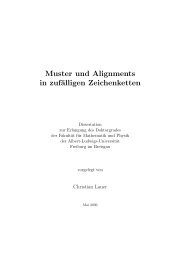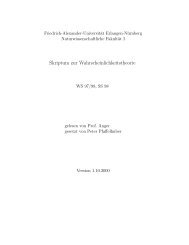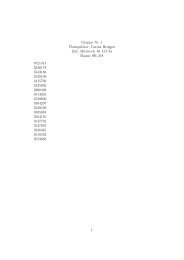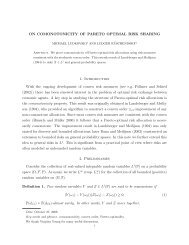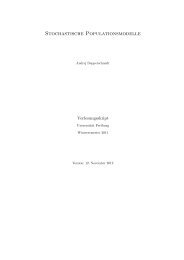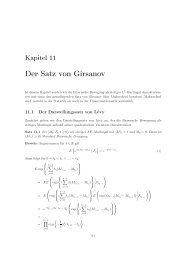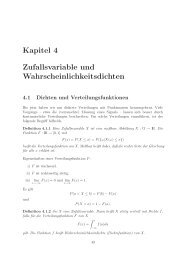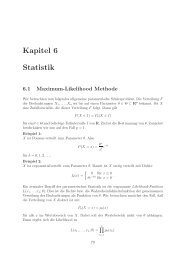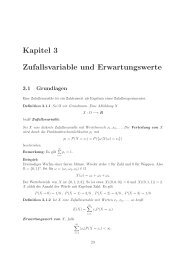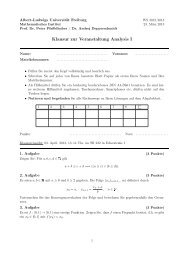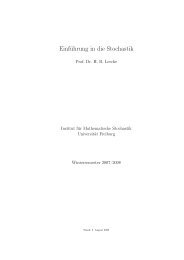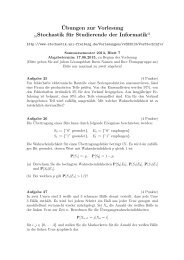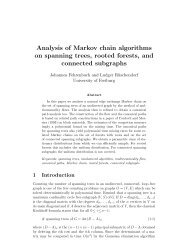On the Internal Path Length of dâdimensional Quad Trees
On the Internal Path Length of dâdimensional Quad Trees
On the Internal Path Length of dâdimensional Quad Trees
You also want an ePaper? Increase the reach of your titles
YUMPU automatically turns print PDFs into web optimized ePapers that Google loves.
where X (k) are iid copies <strong>of</strong> X and {X (k) , k = 0, . . . 2 d −1}, U are independent,<br />
U uniformly distributed on [0, 1] d .<br />
Define<br />
M 0,2 := { µ ∈ M 1 (IR 1 , B 1 ) | IEµ = 0, Var µ < ∞} (26)<br />
where IEµ, Var µ are defined as expectation respectively variance <strong>of</strong> a corresponding<br />
random variable and M 1 (IR 1 , B 1 ) denotes <strong>the</strong> space <strong>of</strong> probability<br />
measures on <strong>the</strong> real line. Define <strong>the</strong> random affine operator<br />
T : M 1 (IR 1 , B 1 ) → M 1 (IR 1 , B 1 ), T (µ) D =<br />
2∑<br />
d −1<br />
k=0<br />
〈U〉 k Z (k) + C(〈U〉) (27)<br />
where (Z (k) ), U are independent, Z (k) D = µ and U is uniformly distributed on<br />
[0, 1] d .<br />
Our aim is to show that T is <strong>the</strong> limiting operator <strong>of</strong> <strong>the</strong> recursive sequence<br />
(X n ) in (14). Supply M 0,2 ⊂ M 1 (IR 1 , B 1 ) with <strong>the</strong> minimal l 2 –metric<br />
l 2 (µ, ν) = inf{(IE|X − Y | 2 ) 1/2 : X D = µ, Y D = ν}. (28)<br />
For random variables X, Y we use synonymously l 2 (X, Y ) = l 2 (IP X , IP Y ).<br />
Then (M 0,2 , l 2 ) is a complete metric space and l 2 (µ n , µ) → 0 is equivalent to<br />
∫<br />
∫<br />
µ D n → µ and x 2 dµ n (x) → x 2 dµ(x). (29)<br />
(see Rachev [13])<br />
Lemma 3.2 T : M 0,2 → M 0,2 is a contraction w.r.t. l 2 :<br />
( ) 2 d/2<br />
l 2 (T (µ), T (ν)) ≤ l 2 (µ, ν) for all µ, ν ∈ M 0,2 . (30)<br />
3<br />
Pro<strong>of</strong>:<br />
Obviously Var (T (µ)) < ∞ and<br />
IET (µ) = 1 + 2 d<br />
2 d −1 ∑<br />
k=0<br />
IE [〈U〉 k ln〈U〉 k ]<br />
= 1 + 2 d 2d IE [〈U〉 0 ln〈U〉 0 ]<br />
= 1 + 2 d 2d ∫[0,1] d u 1 · · · u d ln(u 1 · · · u d ) dλ d (u)<br />
9



